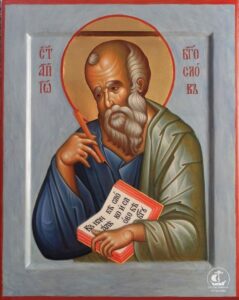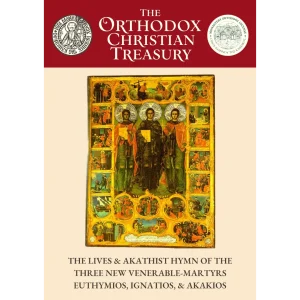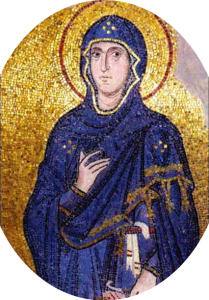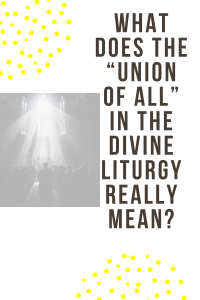SAINT EDMUND, MARTYR-KING OF EAST ANGLIA and Those with Him – November 20
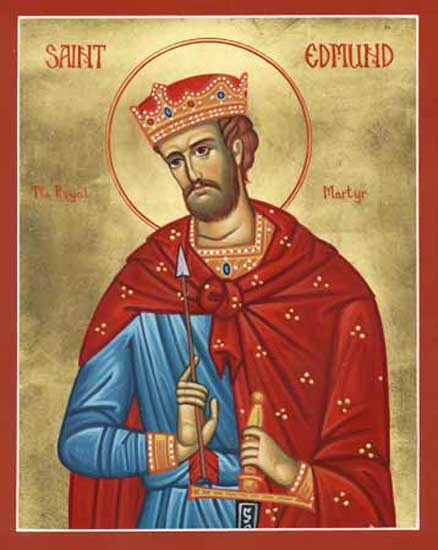
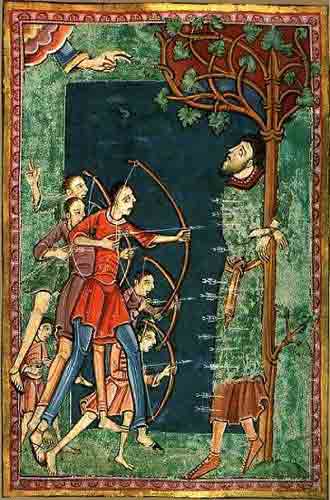
by Dr. Vladimir Moss
| Early Years St. Edmund, one of the greatest and most famous of the British saints, lived and suffered during the ninth century, one of the most tragic and difficult moments of British history, when the pagan Danes were killing and destroying over a large area of the British Isles. The problems of the English were made worse by the fact that there was no unity among them, and instead of being united into one powerful force to repel the invaders they were divided into seven kingdoms, which were not always united even within themselves. No part of the country was more exposed to the pagan attacks than the small kingdom of East Anglia, and the old King Offa of East Anglia resolved to go on a pilgrimage to the Holy Land to pray for the forgiveness of his sins and the safety of his kingdom. On the way, he visited his cousin Alcmund, who, on being exiled from East Anglia after the death of the Martyr-King Ethelbert (+May 20, 793), had been entrusted with the kingdom of Old Saxony by the Emperor Charlemagne. Alcmund had married a German princess named Siwara, and with her often besought the Lord to give him a numerous and saintly family. In answer to his prayer, an angel appeared to him and told him to undertake a pilgrimage to the tombs of the apostles in Rome, where God would grant his petition. During this pilgrimage, while the king was one day conversing with his hostess, a noble and pious Roman woman, she noticed on his breast a brilliant sun, whose rays, darting to all four points of the compass, threw a miraculous light on all around. Filled with the spirit of prophecy, she declared that from him would come a son whose fame, like the sun, would illumine the four quarters of the world and bring many to Christ. A few months later, after returning to North Hamburg, the capital of Old Saxony, Alcmund’s wife Siwara bore him his second son, Edmund. Now when King Offa came to Saxony, Edmund was appointed to accompany him; and the old king was immediately struck by the beauty, both physical and spiritual, of the young prince, and by the zeal of his service. He applied to him the words of Solomon: “Hast thou seen a man swift in his work? He shall stand before kings and shall not be in obscurity” (Proverbs 22.29). Then in the presence of the whole court he embraced him and, putting a ring on his finger, said: “My most beloved son Edmund, accept this memento of our kinship and mutual love. Remember me as one grateful for your service, for which with God’s permission I hope to leave you a paternal inheritance.” Edmund’s father hastened to explain to him the significance of this ceremony: was he prepared to accept King Offa as his adoptive father in place of his natural father? On Edmund’s acceptance, Offa tearfully drew from his finger his ring – in fact, it was a coronation ring – and said: “Son Edmund, observe closely this ring, notice its design and seal. If, when I am far away, I intimate to you by this token my wish and desire, do you without delay execute my order. As the noble assembly here bears witness, I intend to regard you as my most beloved son and heir.” Then Offa continued on his pilgrimage. Having arrived in the Holy Land and venerated the Holy Places, he set out on his return journey via Constantinople. But as he was sailing through the Hellespont, he fell ill; so, disembarking at the monastery of St. George, he received the Holy Mysteries and prepared for death. His last act was to entrust his kingdom of East Anglia to Edmund, ordering his nobles to take his ring to Saxony as a token of his will. Then he reposed in peace and was buried in St. George’s Bay on the Hellespont in the year 854. And so, in his fourteenth year, St. Edmund set sail with a retinue of nobles for the promised kingdom which he had never seen before. They landed at what is now called St. Edmund’s Head near Hunstanton in Norfolk. Disembarking in a dry river-bed, the king prostrated on the ground and prayed to God to bless his coming and make it profitable for the land and its people. As the saint rose and mounted his horse, twelve springs of sweet, clear water gushed out of the earth, which worked many miracles of healing for the sick. From that hour the soil of that region, which before had been sandy and barren, bore the richest crops in all Eastern England. The saint then proceeded to Attleborough, Offa’s former capital, and staked his claim to the throne. On November 5, 855, he was in Winchester, attending a council convened by King Ethelwulf of Wessex (Southern England) to provide a charter of immunities for the English Church. Then he returned to Attleborough, where on Christmas Day he was proclaimed sovereign of the people of Norfolk (the northern half of East Anglia) by Humbert, Bishop of Elmham. For the next year the king stayed quietly in Norfolk, learning the psalms of David under the guidance of Bishop Humbert. Eventually the people of Suffolk (the southern half of East Anglia) decided to accept him as their king, and on Christmas Day, 856 he was anointed and crowned king of the whole of East Anglia. The church in Bures, Suffolk, where the coronation took place, survives to the present day. St. Edmund was fair-haired, tall, well-built, with a natural majesty of bearing. By his piety and chastity he won the respect of all the Christians. He was a defender of the Church, a protector of orphans and widows, and a supporter of the poor. No man sought for justice from him and failed to get redress, and no innocent pleaded in vain for mercy. It is said that under his strong and just rule a boy could drive a mule from Lynn to Sudbury, or from Thetford to Yarmouth, and no one would dare to molest him. The Great Army In 865 the pagan Danes, led by the three brothers Hinguar, Healfdene and Hubba, again invaded England, bent on revenge for the death of their father Ragnar Lodbrog at the hands of the English King Alle of Northumbria. Hinguar carried with him the famous standard of the Raven, which had been woven by the three daughters of Lodbrog for their three brothers. Magical spells had been cast during the weaving, so that when the bird flapped its wings in the wind, it was believed to betoken victory, while when it hung motionless, it betokened defeat. St. Edmund went out to meet the Danes under another banner, which showed Adam and Eve eating from the tree of the knowledge of good and evil and above them the Lamb of God slain to wash away their sins. Edmund defeated the enemy in several skirmishes, showing subtlety no less than valour. Thus he was once surprised by the enemy within one of his camps with no avenue of escape. The siege was so long that both besiegers and besieged began to suffer from famine. But Edmund determined that the enemy should not learn about his men’s suffering, which might persuade them to disband their own troops. So he ordered a fatted bull which had been fed with good wheat to be set loose outside the enclosure. The Danes seized it and killed it. And when they opened its stomach and found fresh wheat inside, they concluded that the English had no lack of provisions. So they abandoned the siege and split up into foraging parties. Edmund then followed them stealthily, and killed large numbers of them. On another occasion Edmund and his men were besieged inside the almost impregnable fortress of Framingham. However, Hinguar captured an old and decrepit man by the name of Sathonius whom the saint had been feeding and accommodating at his own expense in the castle. By means of a bribe, the old man was induced to betray to Hinguar a weak spot in the castle walls, which he himself had helped to build in his youth. Advancing on the castle at this point, Hinguar caught the English by surprise. Edmund jumped onto his swiftest charger and galloped out through the open gates. Some of the Danes saw him, but did not suspect who he was and galloped after him, hoping to get some information about the king. But Edmund, like St. Athanasius the Great on a similar occasion, turned to them and said: “Go back as fast as you can, for, when I was in the castle, the king whom you seek was there also.” Turning back, they discovered that the king had fooled them. Then St. Edmund gathered his forces and fell upon the baffled Danes as they were retreating. The Danes now made peace with Edmund and headed north to Northumbria (North-Eastern England), arriving in York on November 1, 866. The English Kings Osbert and Alle, who had been fighting each other up to that moment, now joined forces and marched on York, and after destroying the city walls they entered the city on March 21, 867. However, the resultant battle within the city was disastrous for the English: both kings and eight of the leading noblemen were killed. The Danes then ravaged the whole of Northumbria as far as the River Tyne before installing an Englishman named Egbert as puppet-king of the region under their power. This was only “the beginning of sorrows” for the English. At the end of the year the Danish “Great Army” moved south into Mercia (Central England) and took the city of Nottingham. In answer to King Burhred of Mercia’s appeal for help, King Ethelred of Wessex, his younger brother Alfred (the future King of England) and St. Edmund came to meet him outside the walls of Nottingham. However, the Danes avoided a battle with the English kings outside Nottingham, so peace terms were concluded. In exchange for giving up Nottingham, the Great Army was allowed to retreat back into Northumbria. Now began a horrific despoliation of the Christian inheritance of the whole of Eastern England. In the north, St. Ebba’s monastery at Coldingham was burned down with the nuns inside after they had all, with Abbess Ebba giving them the lead, cut off their noses and upper lips to deter the attackers from raping them. Tynemouth, Wearmouth, Jarrow, Whitby and other famous monasteries were destroyed; and in Eastern Mercia Bardney and Crowland were gutted. When the news of the Great Army’s approach reached Abbot Theodore of Crowland, he sent away all the able-bodied men and buried the church valuables. Then, as the flames of nearby Kesteven lit up the sky, he calmly vested himself for the Divine Liturgy, which he celebrated with the assistance of Deacon Alfget, Subdeacon Savin and Monks Ethelred and Wulric. Hardly had they finished when the Danish leader Oscytel burst in, beheaded the abbot, tortured the elder monks and killed the boys – there were 70 martyrs in all – before setting fire to the monastery. This took place on August 26, 869. “Theodore’s skull,” writes Nick Smith, “complete with the sword cut that killed him, is now kept in Parvise Chapel [in Crowland] above the porch, inaccessible to casual visitors. It was stolen in 1982, and returned anonymously 17 years later with a ‘crude note of apology’ according to the church guide.” Then it was the turn of the fenland monasteries Thorney, Peterborough, Ramsey and Ely. At Peterborough Hinguar was struck by a stone; so his brother Hubba with his own hand slaughtered Abbot Hedda and 84 monks on one stone to avenge his injury. At Ely a Dane took hold of the pall which covered the incorrupt body of St. Etheldreda (+June 23, 679) and struck the marble of the tomb with his battle-axe. But a splinter flew back from off the ground and entered the striker’s eye, and he fell dead. At this the others left the tombs of the other saints, which they were thinking of violating, and fled. Probably also at this time was killed St. Herefrith of Louth, the last bishop of Lindsey, whose relics were translated to Thorney. Another saint met the invaders in a different way. The body of St. Werburga (+3 February, c. 700) had been preserved incorrupt at Chester right up to the coming of the Danes. But when they approached the city, the body suddenly disintegrated… Martyrdom While Hubba with 10,000 men was sacking Ely and Soham, Hinguar pressed eastwards into East Anglia. On Newmarket Heath he encountered Alderman Ulfcetyl defending two or three earthworks later known as “Holy Edmund’s Fortifications”. The English were overwhelmed and slaughtered to a man. Then the host proceeded to the capital, Thetford, which they captured amidst terrible scenes of rape and butchery. The whole population was killed, and only King Edmund with a small army survived to face the Danes… Hinguar then sent a messenger to Edmund, saying: “Hinguar our king, brave and victorious by sea and by land, has subdued many nations and has now landed suddenly here with his host. Now he orders you to divide your hidden treasure and the wealth of your ancestors with him quickly. And if you want to live, you can be his under-king, because you do not have the power to resist him.” Edmund summoned Bishop Humbert and discussed with him how he should answer Hinguar. The bishop, fearful because of the disaster at Thetford and the threat to the king’s life, counselled him to submit to whatever Hinguar demanded. Edmund replied: “O bishop! This wretched nation is humiliated, and I would rather die in battle against him who is trying to possess the people’s land.” Then the bishop said: “Alas, dear king, your people lie slaughtered, and you do not have the forces to fight. And these pirates will come and bind you alive, unless you save your life by fleeing, or by submitting to him in this way.” The king replied: “What I want and desire with all my heart is that I should not be left alone when my beloved thanes with their wives and children have been suddenly killed by these pirates. It was never my custom to flee, and I would rather die for my country if I have to. And Almighty God knows that I will never renounce His worship, nor His true love, in life or in death.” Then he turned to Hinguar’s messenger and said: “You would certainly deserve to die right now, but I will not dirty my clean hands in your filthy blood, for I follow Christ, Who set us this example. And I will gladly be killed by you if God so ordains it. Go quickly now and tell your savage lord: ‘Edmund will never while living submit in this land to the pagan war-lord Hinguar, unless he first submit in this land to Christ the Saviour in faith.’” Then Edmund marched with his men to Thetford. The battle raged for seven hours on the plain between Melford and Catford bridges; and finally Hinguar and his men retreated to their entrenched camp. Edmund was the victor, but at a terrible cost; and as he marched back to Hoxne he resolved to give himself up rather than continue the blood carnage. Shortly after his arrival in Hoxne, the news came of a fresh Danish inroad into the country. Hubba had completed his destruction of Ely and Soham, and had now set out with 10,000 more men to help his brother complete the conquest of East Anglia. Resistance was now hopeless, and Edmund’s only thought was how to preserve his country from further bloodshed and preserve in it the Christian faith. Bishop Humbert again counselled flight, if only in the hope that he might return to re-conquer the land for Christ. But Edmund knew that the enemy would the more ruthlessly put to sword any able-bodied man who might assist in his restoration. Nor would that be enough: Hinguar entertained a personal hatred of the king which would be satisfied only by his being captured alive… So the saint turned to Humbert and said: “O Bishop Humbert, my father, it is necessary that I alone should die for the people, and that the whole nation should not perish (cf. John 12.50).” Then, having dismissed his men and laid aside his arms, he entered the church and prostrated himself in front of the altar, praying for strength for his feat of martyrdom for Christ and his suffering people. Having marched up to the town and surrounded it, Hinguar sent his men into the church with orders to touch no one except the king. They seized the king, bound him, and beat him with cudgels while insulting him continually. Then they tied him to a tree and flogged him with whips for a long time. Meanwhile the king called unceasingly on the name of Christ. This infuriated the pagans, and they now shot at him with arrows until he was entirely covered with them, like the holy Martyr Sebastian. When Hinguar saw that the holy king would not renounce Christ, he ordered him to be beheaded. And so they dragged him, still calling on Christ, to the place of slaughter and there beheaded him. Then Bishop Humbert, too, was led into the arena and beheaded. This took place on November 20, 869, when Edmund had reigned for fifteen years and was twenty-nine years old. The Translation of the Body The pagans returned to their ships, having thrown the head of St. Edmund into dense brambles so that it would be left unburied. Then the local inhabitants came and found the headless body, but could not find the head. A man who had been a witness of the martyrdom said that he thought that they had hidden the head somewhere in the wood. So a search-party was organized which scoured the bushes and brambles. And as they were calling to each other, they head answered “Here! Here! Here!”, until they all came to the place where the head lay. And there they saw it lying between the two paws of a grey wolf, who, while not daring to harm it himself, had been protecting it from the other wild beasts. Thanking God Almighty for His miracles, the people took the head and carried it back to the town. The wolf followed them as if he were tame, and then, having seen it into the town, returned to the wood. The people joined the head back to the body, and then buried it as best they could, hastily erecting a wooden chapel over it… Within twenty years coins were being minted depicting Edmund as a saint. One night, a blind man and a boy who was leading him were walking through the woods near Hoxne. Not seeing any house nearby, they resolved to stay the night in what was in fact the wooden chapel constructed over St. Edmund’s grave. Upon entering, they stumbled across the martyr’s grave; but, though terrified at first, they decided not to leave but to stay in the chapel, using the grave as a pillow for the night. Hardly had they closed their eyes, when a column of light suddenly illumined the whole place. The boy woke up his master in fear. “Alas! Alas!” he cried, “our lodging is on fire!” But the blind man calmed him down, assuring him that their host would not let them come to harm. And indeed, at dawn they discovered that through St. Edmund’s prayers the blind man could now see. The news of this miracle spread throughout East Anglia, and the people resolved to translate the body of their saint to a safer and more honourable shrine. They chose the town of Bedricsworth whose church and monastery, founded by St. Sigebert in the seventh century, had been destroyed by the Danes, but some of whose priests still survived. In 903, having rebuilt the church, Bishop Theodred of Elmham and all the clergy of East Anglia translated the holy body with great ceremony into its new shrine. The town was renamed Bury St Edmunds in the saint’s honour. “Then there was a great miracle,” wrote Abbot Aelfric in about the year 1000, “in that he was just as whole as if he were alive, with unblemished body; and his neck, which was previously cut through, was healed, and there was, as it were, a red silken threat about his neck as an indication to men of how he was slain. Likewise the wounds which the savage heathens had made in his body with repeated missiles were healed by the heavenly God. And he lies incorrupt thus to this present day, awaiting resurrection and the eternal glory. His body, which lies here undecayed, proclaims to us that he lived here in the world without fornication, and journeyed to Christ with a pure life. A certain widow called Oswyn lived in prayer and fasting at the saint’s tomb for many years afterwards; each year [on Holy Thursday] she would cut the hair of the saint and cut his nails, circumspectly, with love, and keep them on the altar in a shrine as relics.” Many miracles continued to be performed at the saint’s tomb. At night a column of light was often seen rising above it and illuminating the whole church. Then, in 925, King Athelstan founded a community of four priests and two deacons to look after the shrine, their duties being similar to those of the seven clergy who guarded the shrine of St. Cuthbert. “Then,” continues Abbot Aelfric, “the inhabitants venerated the saint with faith, and Bishop Theodred [the second of the name, called “the Good”] endowed the monastery with gifts of gold and silver in honour of the saint. Then at one time there came wretched thieves, eight in a single night, to the venerable saint; they wanted to steal the treasures which men had brought there, and tried how they could get in by force. One struck at the bolt violently with a hammer; one of the, filed around it with a file; one also dug under the door with a spade; one of them with a ladder wanted to unlock the window. But they laboured in vain and fared miserably, inasmuch as the holy man miraculously bound them, each as he stood, striving with his tool, so that none of them could commit that sinful deed nor move away from there, but they stood thus till morning. Then men marvelled at how the villains hung there, one up a ladder, one bent in digging, and each was bound fast in his labour. Then they were all brought to the bishop, and he ordered them all to be hung on a high gallows. But he was not mindful of how the merciful God spoke through His prophet the following: Eos qui ducuntur ad mortem eruere ne cesses, ‘Always redeem those whom they lead to death’; and also the holy canons forbid those in orders, both bishops and priests, to be concerned with thieves, for it is not proper that those who are chosen to serve God should be a party to any man’s death, if they are the Lord’s servants. Then after Bishop Theodred had examined the books, he repented with lamentation that he had appointed so cruel a judgement to those wretched thieves, and regretted it to the end of his life, and earnestly prayed the people to fast with him a whole three days, praying to the Almighty that He would have mercy on him. “There was in that land a certain man called Leofstan, powerful before the world and foolish before God, who rode to the saint with great arrogance, and insolently ordered them to show whether the holy saint was uncorrupted; but as soon as he saw the saint’s body, he immediately went insane and roared savagely and ended miserably by an evil death.” Vengeance on the Pagans In the year 1013, the Danes under King Swein again invaded England, and the whole country north of Watling Street surrendered to him. London, however, under the leadership of King Ethelred and Earl Thurkill, held out against him for some time. But when Swein turned northwards again, the whole nation accepted him as their undisputed king, and even the Londoners were forced to submit, while the king, the royal family and Bishop Alfhun of London went into exile in Normandy. At this critical juncture, still more critical than that which faced King Alfred in the winter of 877-878, an English saint again came to the rescue of the Christian people – this time, the holy Martyr-King Edmund. Since the year 999, the incorrupt body of St. Edmund had been in the care of a monk named Ethelwine. In 1010, relates Abbot Sampson, when the Danes were ravaging East Anglia, St. Edmund’s earthly kingdom, the saint appeared to Ethelwine and ordered him to place his body in a casket, put it on a cart and convey it to London. But the clerics were to remain in their places. At dusk one day, as Ethelwine was proceeding on his way to London, he came to the house of a priest named Edbriht, and asked hospitality for himself and his holy charge. The priest at first refused to give shelter to strangers; but eventually, after people protested, he allowed the monk to sleep in the open air on his land, while not allowing him into his house. So Ethelwine slept under the cart on which the martyr’s body lay. That night, however, a column of light was seen stretching up from the cart to heaven, and during the fourth watch of the night, the cart began to make a noise as if its wheels were turning. Startled by the noise, Ethelwine woke up and understood that the saint wished to move from there. Soon he was on his way, and when he was already some distance from the house, he looked back and saw that it was on fire – a just retribution for the priest’s inhumanity. Later that day, Ethelwine came to the crossing of the river Stratford, three miles from London, and wished to cross over. But part of the bridge had subsided into the river, and the whole structure was unsafe. The Danes threatened from the rear, and there was no other crossing; so Ethelwine resorted to prayer. Suddenly the cart began to move of its own will. The right wheel rolled over what remained of the bridge, while the left wheel passed through the air above the water as if it were dry land. Those who saw the miracle from the other side of the river praised God, and as the holy body approached the outskirts of London a great crowd of monks, clerics and nobles came to meet it. Taking it upon their shoulders, they moved towards the church of St. Paul, singing praises and rejoicing greatly. Between the Aldgate and the church of St. Paul eighteen people were cured of various maladies through the prayers of the saint. A woman who was confined to her bed with paralysis heard the clamour accompanying the passing of the saint and asked her servants what it signified. “Don’t you know,” they said, “that St. Edmund, the king of the East Angles, who was innocently killed for Christ by the unfaithful and impious pagans, has come into this city and has given health to many?” “Woe is me!” she cried, “that God has not counted me worthy to obtain mercy in his presence. For if I could just touch the edge of his bier, I am confident that I would be immediately healed of my infirmity.” So saying, she suddenly stood on her feet completely healed – the nineteenth cure to the glory of the saint that day. Realizing what had happened, she rushed into the crowd and with tears pressed her lips to the saint’s bier. Now the procession came to the church of St. Gregory, near St. Paul’s. The holy body was let down and all the people prostrated in prayer to the saint. At this point a Dane who was curious to know what was happening came on the scene. Seeing the others prostrate in prayer, he proudly remained upright, and, drawing aside the veil which covered the body, he peered inside. Suddenly he was struck with blindness. Then, realizing his sin, he confessed it, promised amendment of life and faithfulness to God and St. Edmund, and implored forgiveness. All those present joined their prayer to his, and lo! his sight was restored. Then he took off his golden armlets and offered them to the saint. Moreover, he was as good as his word and led a pious life thereafter. For almost three years the fame of the martyr spread far and wide through the miracles of healing, both bodily and spiritual, wrought through the intercession of the saint in London. Then St. Edmund appeared in a vision to Ethelwine and ordered him to bring his body back to Bury St. Edmunds. Immediately the monk went to Bishop Alfhun with a request to leave, explaining that he had come to London rather as a pilgrim than as a permanent resident. The bishop acceded to his request, though reluctantly. But when Ethelwine, had gone, he hastened with three clerics to the church of St. Gregory. There they tried to lift the holy body in its reliquary onto their shoulders. But to no avail: the weight was insupportable. Four more men joined them, then twelve, then twenty-four. But after much sweat and labour they had not succeeded in moving the reliquary a single inch. Then the bishop with his men felt ashamed, realizing that their devotion, though pious, was contrary to the will of God and St. Edmund. When Ethelwine came up, however, and prayed in the presence of the saint, he was able with three of his companions to life the reliquary as though it weighed nothing. So he set out on his journey, but not unnoticed as before. For a great crowd of clergy and people followed him in great sorrow as far as the Stratford bridge, and beyond it all the villages along the route poured out to meet the saint with great joy. Bridges were repaired and roads cleared. And, as in London, many miracles took place. Near Stapleford, the lord of the village gave hospitality to the saint and was cured of a chronic illness; whereupon he donated a manor to the saint in perpetuity. Finally, the holy treasure was received by the clerics of Bury St. Edmunds and placed with all devotion in its former resting-place. There, for centuries to come, miracles did not cease for those who sought with faith. In 1014 the Danish King Swein came to Bury St. Edmunds, demanding tribute and threatening that if it was not paid he would burn the town with the townsfolk, destroy the church of the saint from its foundations and torture the clerics in various ways. But the townsfolk refused, trusting in the protection of St. Edmund. Nor did the tax-collectors dare to use force against them, for they had heard how the saint protected his own. So they hastened to the king and informed him of the rebellion against his authority. Meanwhile, not only the townsfolk of Bury St. Edmunds but also people from all over East Anglia hastened to the church of the saint to beseech him by prayers, fasting and almsgiving to free the land from the yoke that had been imposed upon it for ten years or more. Moreover, they asked Monk Ethelwine to make a special intercession for them at the shrine of the saint, that he would in his accustomed manner reveal a means of salvation for them through a nocturnal visitation. That night, therefore, St. Edmund appeared to Ethelwine in his sleep, with joyful countenance and in shining white garments, and said: “Go to King Swein and tell him this from me: ‘Why do you vex my little flock by imposing on them a yoke that no other king has imposed upon them? Tribute has never been demanded of, nor paid by, them at any time since my repose. Therefore correct this unjust sentence, lest, when you wish to, you will be unable to. For if you do not obey my admonition, you will soon know that you displease both God and myself; for you will discover that East Anglia has me as her protector.'” So Ethelwine obediently sought out King Swein at Gainsborough, and humbly doing obeisance, delivered the saint’s message, mixing soft words with the harsh. But the king refused to listen, ordered the monk out of his sight, and showered the saint with abuse, saying that he had no holiness. Seeing that the king had no fear of God nor reverence for the saint, Ethelwine sadly turned back. Near Lincoln he was given hospitality for the night; and as he was sleeping peacefully, St. Edmund appeared to him and said: “Why are you fearful and sad? Have you forgotten my words and incurred the risk of falling into despair? Rise immediately and continue your journey; for before you will have reached its end, news about King Swein will delight you and all your compatriots.” Strengthened by this revelation, Ethelwine rose and set off on his way before dawn. As he was travelling he heard the sound of Danish horsemen behind him. One came up, greeted him, and said: “By your leave, are you the priest whom I saw the day before yesterday delivering the orders of a certain king to King Swein?” “I am.” “Alas, alas,” he said, “how weighty was your threat! How true your prophecy! For the death of King Swein has left England glad and Denmark in mourning. The night after you left, the king went to bed happy and fearing nothing. The whole palace was sleeping soundly. Suddenly the king was woken up by an unknown soldier standing before him, a man of wondrous beauty and brandishing arms. Addressing the king by his own name, he said: ‘Do you want tribute from St. Edmund’s land, O king? Get up – here it is.’ He got up but fell back on his bed, terrified at the sight of the arms, and began to cry out. Then the soldier went up to him, thrust him through with his lance and left. Hearing his cry: ‘Help! Help! St. Edmund has come to kill me!’, his men came rushing in and found him dead, covered in his own blood.” Marianus relates that at that moment in Essex, a pious man named Wulfmar who had been ill for three days with a disease that deprived him of the use of his tongue and of all his limbs, suddenly sat up on his bed in the presence of his parents and neighbours, and said: “On this night and at this hour King Swein has been killed, pierced through with the lance of St. Edmund.” Saying this, he fell back on his bed and died. When Ethelwine heard this news, he judged the time opportune to publish what he had previously covered in silence. The story then spread like wildfire throughout the province, inciting all the English to refuse to pay tribute. King Swein perished on the feast of the Meeting of the Lord, February 2, 1014, and his body was placed in salt and shipped back to Denmark. Thus was the Scripture fulfilled: “The saints shall boast in glory, and they shall rejoice upon their beds. The high praise of God shall be in their throat, and two-edged swords shall be in their hands, to do vengeance among the heathen, punishments among the peoples, to bind their kings with fetters, and their nobles with manacles of iron, to do among them the judgement that is written. This glory shall be to all His saints.” (Psalm 149.5-9) St. Edmund is commemorated on November 20, the date of his martyrdom, and April 29, the date of his translation. Holy Martyr-King Edmund, pray to God for us! (Sources: Abbot Aelfric, Passio Sancti Eadmundi; Anglo-Saxon Chronicle, E, 870, 1013; Nova Legende Anglie, Appendix II, pp. 596-602; Rev. J.B. Mackinlay, Saint Edmund King and Martyr, London, 1893; David Farmer, The Oxford Dictionary of Saints, Oxford: The Clarendon Press, 1978, pp. 120-122; Nick Mayhew Smith, Britain’s Holiest Places, Bristol: Lifestyle Press, 2011, pp. 142-148, 282) |

